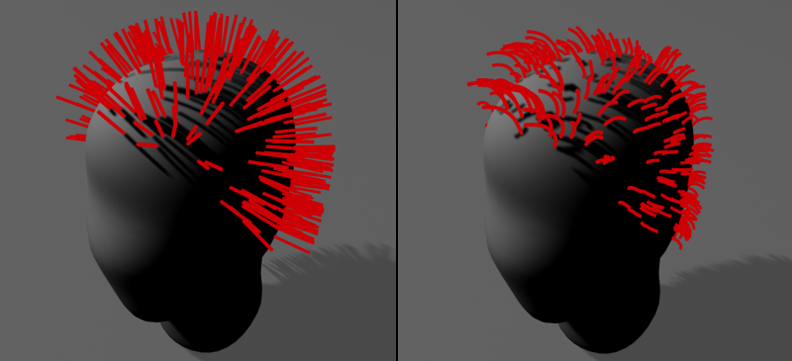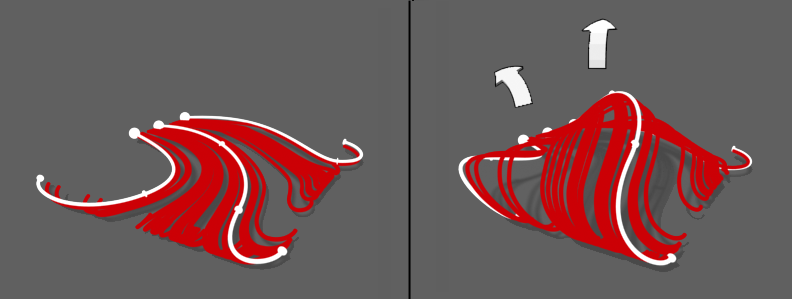The Hair And Fur modifier is the heart of the Hair And Fur feature. You apply it to any object that you want to grow hair from: either a mesh object or a spline object. If object is a mesh, the hair grows from the entire surface unless you make a sub-object selection. If the object is a spline, hair grows between the splines.
When you select an object modified by Hair And Fur, hair is displayed in viewports. The hair itself as displayed in the viewports is not selectable, though hair guides are selectable when you work at the Guides sub-object level or style hair (see below).
Hair And Fur renders by “tiles,” which are 2D projections of the 3D space that the hair or fur occupies. Each tile is displayed in the rendered frame window as soon as it is generated. Also, you can set the maximum memory that a tile uses at render time; see Hair And Fur Render Effect.
Hair And Fur can take advantage of multiple processors, improving rendering time on multiprocessor systems.
Components of the Hair And Fur Feature
Hair And Fur in 3ds Max comprises several components:
- The Hair And Fur modifier is the main component. This is where you style the hair guides, and set parameters for size and coloration, kinkiness, frizziness, and so on.
- The Hair And Fur Render Effect controls more directly how hair is rendered. Typically you don't need to change the render effect parameters, unless you have special rendering requirements.
A Hair And Fur render effect is automatically added to your scene when you apply the Hair And Fur modifier.
- A Hair Light Attr(ibutes) Rollout appears for all supported lights when a Hair And Fur render effect is active using the scanline renderer, and the render effect's Use All Lights At Render Time toggle is turned on. Controls on this rollout let you fine-tune how hair shadows appear under specific lights.
The following light types are not supported when rendering hair with the “buffer” method (see “Lighting Considerations,” below): Skylight, mr Area Omni, mr Area Spot, IES Sun, IES Sky, mr Sky and mr Sun. However, mr Area Omni, mr Area Spot, mr Sky, and mr Sun are supported for hair when you set the Hairs rendering option to “mr prim” and render with mental ray.
Note: For the purposes of rendering shadows in hair, Direct lights are treated as point (omni) lights. - The Hair And Fur Render Element is useful when you do post-render compositing.
Growth Objects
You can grow Hair either from a surface or from splines.
To grow hair from a surface, select the object and then apply the Hair And Fur modifier. You can use either geometric primitives or an editable surface type such as Polymesh.
To grow hair from splines, you can draw several splines and combine them into a single object (or turn off Start New Shape during creation), and then apply the Hair And Fur modifier. You will see some preview interpolated hairs appear in viewports. The order of the spline sub-objects is important because Hair uses this order to interpolate hair in between the splines. If the interpolation seems incoherent, you might need to physically rearrange the splines.

Using a spline emitter, Hair interpolates hair growth between pairs of splines in logical, numerical order.
Left: Splines in sequential order result in predictable hair growth.
Right: Splines in nonsequential order can produce undesirable results.
Guide Hairs
Storing and manipulating millions of dynamic, simulated hairs is demanding on today’s technology. Therefore, just as standard 3D graphics technology uses boundaries such as surfaces to describe solid objects, Hair uses hair “guides” to describe basic hair shape and behavior.

Guides (yellow) occur at each polygon corner.
Hairs (red) are interpolated between guides.
When the growth object is a surface, Hair And Fur generates guide hairs at the corners of polygons. When the growth object is a spline, the spline sub-objects are themselves the guides.
For surface-grown hair, you can manipulate the guides with styling tools to form a “control volume” that gets populated by interpolated hairs. The hairs can then be further manipulated with distorting controls such as Kink and Frizz, which can be driven by maps or solid textures.

Frizz settings affect the hairs but not the guides.
By default, a percentage of hairs are displayed in the viewports, but surface-grown guides do not appear except when you are working at the Guides sub-object level. You can adjust the viewport display of guides and hairs with settings on the Display rollout.
Guides are also used to calculate dynamics. After this calculation, hair interpolation takes place when you render. This is when parameters such as Frizz, as well as displacement and coloration, are calculated. You don't have control of every single hair, but this two-phase process makes the creation of realistic hair computationally feasible on a typical computer.
Styling Hair
The Hair And Fur modifier's growth settings have a great effect on the hair’s appearance and behavior, but you can also manipulate the guides directly (or in other words, style the hair).
For surface-grown hair, use the tools on the Styling rollout. First, select the surface whose hair you want to edit, and then on the Modify panel, either click the Style Hair button on the Styling rollout or choose the Guides sub-object level from the Selection rollout or the modifier stack display.

After guides have been styled, hair is interpolated between neighboring guide pairs.

Mesh-based hair guides before and after styling.
With spline growth, you style the hair by editing the growth splines in the viewports.

Style spline-based hair by manipulating the splines.
Copying and Pasting Hair
You can copy and paste a Hair And Fur modifier from one stack to another, but you need to line up the objects as closely as possible, because Hair uses proximity to determine how to position copied guides. If the objects have significantly different geometry, the transfer of guides can be inaccurate.
Copying and pasting the Hair And Fur modifier automatically adjusts the hair scaling. Copying from a large object to a small object, for instance, results in a smaller default size in the copied modifier.
If you copy an object that has Hair And Fur in its modifier stack, Hair will also copy the modifier’s data to a new modifier that will track the new object.
Textures, Vertex Maps, and Shaders
You can control many Hair And Fur modifier parameters with maps. If you apply a map to a parameter that is not a color, such as Density, Hair uses the texture as a grayscale map that is multiplied by the parameter value (0.0 to 100.0) .
You apply a map by clicking the square button to the right of the parameter. After applying a map, the letter “M” appears on the button. To place this map in the first slot in the Material Editor,  +click the button. To disable the map temporarily,
+click the button. To disable the map temporarily,  +click the button. A disabled map is indicated by a lower-case “m”.
+click the button. A disabled map is indicated by a lower-case “m”.
Lighting Considerations
When you render using the default “buffer” method, Hair And Fur provides its own default lighting (a single omni light), unless you have one or more supported lights in the scene.
Supported lights for the scanline renderer and “buffer” method include spotlights, omni lights, direct lights (which are treated as omni lights for hair purposes), and photometric lights except for IES Sun and IES Sky. Supported lights for the mental ray renderer and “mr prim” method include the lights supported by the scanline renderer, and these mental ray light types: mr Area Omni Light, mr Area Spotlight, mr Sky, and mr Sun.
If supported lights exist in the scene, by default they are used to light the hair, and the internal default omni light is not used. This is because in the Hair And Fur Render Effect, the Use All Lights At Render Time option is on by default. Also, any supported lights set to cast shadow-mapped shadows will cast shadows from rendered hair.
For Hair’s “buffer” render to consider only certain lights, select the lights you’d like Hair to use, go to the Hair And Fur render effect, turn off Use All Lights At Render Time, and then click Add Hair Properties. This causes only the designated lights to illuminate the hair. It also adds a Hair Light Attr(ibutes) Rollout to each of the designated lights. This lets you fine-tune the light's shadow settings for Hair.
With the “buffer” method, you can also raytrace your scene.
Loading and Saving
Hair And Fur data in your scene is automatically saved when you save your MAX scene file. The state data for the hair can consume quite a bit of space, so your scene file will probably be significantly larger than it was before you applied hair.
Animating Hair
You cannot keyframe hair styling. You can keyframe Modify panel parameters to create special effects such as hair growing. But to animate hair motion, you can use the Frizz Animation parameters or use dynamics.
To animate frizz, use the Frizz Anim., Anim. Speed, and Frizz Anim. Dir. parameters. It's not necessary to keyframe these to create animation; just set them to values other than the defaults.
To animate with dynamics, use the Dynamics rollout. See To generate a precomputed dynamics simulation with Hair. A gravity force is built in to Hair And Fur. You can add space warps to act as external forces (for example, Wind).
Procedures
To use the Hair And Fur modifier:
- Apply the Hair And Fur modifier to a mesh or spline object.
The hairs appear in the viewports as brown lines.
- Set the modifier parameters according to the desired results (see Topics in this Section, following). Available settings include the number of hairs, length, thickness, and coloring.
- Activate a Perspective or Camera viewport, and then render the scene.
Hair cannot render in an orthographic viewport.
This procedure lists the essential steps for growing hair on an object. For more information, see other Hair And Fur topics in this help.
To apply hair to a limited area of a high-resolution object:
- Create the object to which you wish to apply hair.
- Make a copy of the object in the same location as the original, remove any geometry where hair shouldn't grow, and reduce the polygon count. For example, you could use the MultiRes modifier.
- If the original object is to move, make the low-resolution proxy object a child of the original object.
- Apply the Hair And Fur modifier to the low-resolution proxy object and adjust as necessary.
- Make the low-resolution proxy object non-renderable (see General Panel (Object Properties Dialog)). The hair will still render.
An efficient working method for applying hair to part of a high-poly-count object is to use a low-poly proxy object.